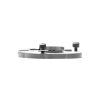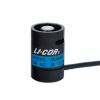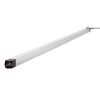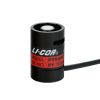LI-COR LI-210R Photometric Sensors
Features
- Provides a spectral response that matches the CIE curve within +/-5% with most light sources
- Sensors are used to measure lighting conditions where the eye is the primary receiver
- Removable sensor simplifies installation and removal of the sensor
- Free ground shipping
- Expedited repair and warranty service
- Lifetime technical support
- More
Overview
The LI-210R Photometric Sensor measures light with the same sensitivity as a typical human eye. The photometric sensor is ideal for evaluating illumination in work areas, exhibits, interior lighting, and in public spaces.
Mechanics
The LI-210R measures light with a precision-filtered silicon photodiode that is sensitive to light centered in the visible spectrum. It responds to light with sensitivity that is close to the human eye, as described by the International Commission on Illumination (CIE) Standard Observer Curve. Cosine corrected to 82° incident angles for accurate measurements when the light source is not directly overhead.
- Absolute Calibration: ± 5% traceable to the U.S. National Institute of Standards and Technology (NIST)
- Sensitivity: Typically 30 μA per 100 klux
- Linearity: Maximum deviation of 1% up to 100 klux
- Response Time: Less than 1 μs (2 m cable terminated into a 604 Ohm load)
- Temperature Dependence: ± 0.15% per °C maximum
- Cosine Correction: Cosine corrected up to 82° angle of incidence
- Azimuth: < ± 1% error over 360° at 45° elevation
- Tilt: No error induced from orientation
- Detector: High stability silicon photovoltaic detector (blue enhanced)
- Sensor Housing: Weatherproof anodized aluminum housing with acrylic diffuser and stainless steel hardware; O-ring seal on the sensor base
- Size: 2.36 cm Diameter × 3.63 cm (0.93” × 1.43”)
- Weight: 24 g head; 60 g base/cable (2 m) with screws
- Cable Length: 2 m, 5 m, 15 m, 50 m (6.5’, 16.4’, 49.2’, 164’)
In The News
With A Modular Update, LI-COR Terrestrial Light Sensors Shine
For environmental professionals looking to measure light, the sun’s energy or photosynthetically active radiation, there is no better choice than LI-COR’s all-new line of terrestrial light sensors. The series, including the LI-190R, LI-200R and LI-210R, has been redesigned from the ground up and is more convenient, reliable and durable than ever before. The new design centers on a modular setup that lets users detach the sensor head from the base. This makes it possible to swap out sensor heads for calibration or to measure different light parameters. In addition, it adds to project flexibility, saving users time and money.
Read MoreApplied Research and Innovative Solutions: Creating CHNGES at Western Kentucky University
Long-standing environmental monitoring programs have the power to support a large number of research initiatives and policy changes—however, actually starting these networks can prove challenging. Not only is starting the program difficult, but keeping things operational for decades to come has also been challenging for environmental professionals hoping to make an impact with applied research. Jason Polk, Professor of Environmental Geoscience and Director of the Center for Human GeoEnvironmental Studies (CHNGES) at Western Kentucky University, is all too familiar with this process.
Read MoreCombating Water Insecurity in Saskatchewan with Real-Time Data
The prairies of Saskatchewan can be described as one of the least water-secure parts of Canada, making water quality monitoring essential for informed resource management in a region already facing water insecurity. While natural physical properties worsen some of the poor water quality conditions in the region, others are connected to land use. Having grown up spending summers on the shores of Lake Huron, Helen Baulch, an associate professor at the School of Environment and Sustainability at the University of Saskatchewan , has always been dedicated to the protection of water resources. Looking back fondly at her childhood playing along the shore, Baulch also recalls the invasion of quagga mussels during her teenage years and watching the lake change as a result.
Read More

































